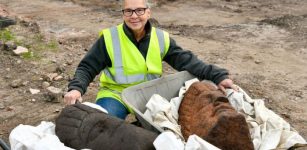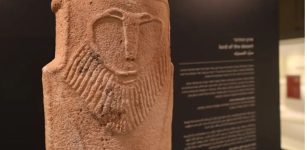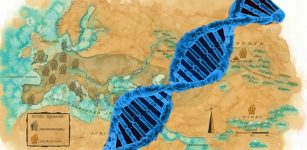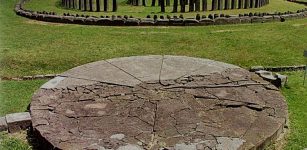Anartes: Forgotten Celtic Tribe And The Hercynian Forest With Strange Animals
A. Sutherland - AncientPages.com - The history of the Celts is not about a group of single people but rather the sum of the individual histories of the tribes that all together formed a Celtic culture. Undoubtedly, many of these Celtic tribes have been lost to history and many others are only known by their names.
Several tribes of the Celtic peoples, however, have their history recorded to some extent and one of them is a major tribe of Anartes (Anarti, or Anartoi).
Detail from the 9th European Map of a medieval edition of Ptolemy's Geography, with the Celtic-Dacian Anartes tribe and the city of Docidava highlighted. image source
Enigmatic Anartes probably lived in the region of ancient Dacia that today is occupied by Romania, parts of Slovakia, and even parts of southeastern Poland, according to some scholars.
Gaius Julius Caesar claimed that the territory of the Anartes was on the eastern border of the Hercynian Forest, a mysterious forest, which is also mentioned by Aristotle, Pliny the Elder, and Tacitus in his works 'Germania' written in 98 AD and the 'Annals of Tacitus'.
The forest was a very dark, dense, and unpenetrable place with bottomless bogs. It was an unknown realm, in which the rivers flowed northward, so vast in its extent that one could not go from one end of it to the other in sixty days’ march.
Among gigantic oaks with mighty intertwined branches, lived very strange animals, wrote Caesar in the sixth book of 'Commentaries on the Gallic Wars. These animals were antlered elks and unicorns, the ancient ox called 'aurochs and a beautiful bird with feathers that glowed like flames flitted among the numberless emerald leaves...'
This most unusual forest extended along with the Danube to the borders of the Daci and Anartes, according to Caesar's description.
It is said that the Hercynian Forest 'stretches, for a distance of 9 days' journey for a fast traveler, along the Danube as far as the borders of the Dacian and the Anartes'. The area of the forest was so large that it comprised the whole northern Danubian region from the Rhine and Danube in the west to Transylvania and the Carpathians in the east. The ancient Celtic history confirms that the Anartes was one of the only tribes ever uprooted completely by the Romans and moved to one of the provinces bordering on the Danube as a punishment for failing to lend military support to the famous philosopher-emperor Marcus Aurelius (121 – 180 AD).
At some point following their migration eastwards as far as Transylvania; they found their homeland and they encountered the Dacians, who were already settled there, which was revealed by archaeological excavations conducted in the region.
The Dacians are thought to have been related to the Thracians (non-Celtic people). The Celtic Anartes became finally culturally assimilated by the Dacians.
Written by – A. Sutherland - AncientPages.com Senior Staff Writer
Copyright © AncientPages.com This material may not be published, broadcast, rewritten or redistributed in whole or part without the express written permission of MessageToEagle.com
Expand for referencesMore From Ancient Pages
-
 Cupbearer Was Privy To Conversations And Political Secrets Hidden Behind Closed Doors
Featured Stories | Oct 5, 2020
Cupbearer Was Privy To Conversations And Political Secrets Hidden Behind Closed Doors
Featured Stories | Oct 5, 2020 -
 Did Human Middle Ear Evolve From Fish Gills? – Chinese Fossils Reveal
Archaeology | Jun 17, 2022
Did Human Middle Ear Evolve From Fish Gills? – Chinese Fossils Reveal
Archaeology | Jun 17, 2022 -
 Unique And Priceless Large Roman Sculptures Found At Carlisle Cricket Club
Archaeology | May 25, 2023
Unique And Priceless Large Roman Sculptures Found At Carlisle Cricket Club
Archaeology | May 25, 2023 -
 Ancient History Of The Samurai Armor
Featured Stories | Aug 27, 2018
Ancient History Of The Samurai Armor
Featured Stories | Aug 27, 2018 -
 Ancient Tomb Chamber Of Parthian Warrior Was Accidentally Unearthed In Iran
Archaeology | Apr 30, 2020
Ancient Tomb Chamber Of Parthian Warrior Was Accidentally Unearthed In Iran
Archaeology | Apr 30, 2020 -
 Never-Before-Seen Ancient Statue Of The ‘Lord Of The Desert’ Revealed To The Public – But Who Was He?
Artifacts | Mar 19, 2022
Never-Before-Seen Ancient Statue Of The ‘Lord Of The Desert’ Revealed To The Public – But Who Was He?
Artifacts | Mar 19, 2022 -
 4,500-Year-Old Board Games And Game Pieces Unearthed At Gath
Archaeology | Jun 19, 2022
4,500-Year-Old Board Games And Game Pieces Unearthed At Gath
Archaeology | Jun 19, 2022 -
 Viking House The Size Of Two Tennis Courts Discovered In Norway
Archaeology | Jul 20, 2023
Viking House The Size Of Two Tennis Courts Discovered In Norway
Archaeology | Jul 20, 2023 -
 3,500 Underground Man-Made Maresha/Beit Guvrin Caves And Tunnels In The Holy Land
Featured Stories | Jun 1, 2014
3,500 Underground Man-Made Maresha/Beit Guvrin Caves And Tunnels In The Holy Land
Featured Stories | Jun 1, 2014 -
 Ancient Stone Ram Figurine – Symbol Of Abundance And Great Courage – Unearthed In Old Cemetery
Archaeology | Oct 2, 2020
Ancient Stone Ram Figurine – Symbol Of Abundance And Great Courage – Unearthed In Old Cemetery
Archaeology | Oct 2, 2020 -
 Genetic Fingerprints Of Unknown Species Discovered In Human DNA
Human Beginnings | Dec 31, 2019
Genetic Fingerprints Of Unknown Species Discovered In Human DNA
Human Beginnings | Dec 31, 2019 -
 On This Day In History: Berlin Opened For One Day – On Dec 20, 1963
News | Dec 20, 2016
On This Day In History: Berlin Opened For One Day – On Dec 20, 1963
News | Dec 20, 2016 -
 Ancient Aqueduct System Discovered In Boroujerd, Lorestan
News | Sep 16, 2015
Ancient Aqueduct System Discovered In Boroujerd, Lorestan
News | Sep 16, 2015 -
 Piecing Together Scotland’s Religious Past With Shards Of Glass
Archaeology | Feb 28, 2023
Piecing Together Scotland’s Religious Past With Shards Of Glass
Archaeology | Feb 28, 2023 -
 Mysterious Tunnel Found Under Saxon Palace Ruins In Warsaw, Poland
Archaeology | Sep 14, 2023
Mysterious Tunnel Found Under Saxon Palace Ruins In Warsaw, Poland
Archaeology | Sep 14, 2023 -
 King Geirrod Betrayed His Brother Agnar And Sent Him To Die But Justice Finally Prevailed
Featured Stories | Feb 14, 2024
King Geirrod Betrayed His Brother Agnar And Sent Him To Die But Justice Finally Prevailed
Featured Stories | Feb 14, 2024 -
 A 1,000-Year-Old Intact Mummy Unearthed In Ancient Pachacamac Site, Peru
Archaeology | May 31, 2018
A 1,000-Year-Old Intact Mummy Unearthed In Ancient Pachacamac Site, Peru
Archaeology | May 31, 2018 -
 Sarmizegetusa And Its Andesite Sun Artifact Similar To The Mayan Calendar
Artifacts | Apr 13, 2021
Sarmizegetusa And Its Andesite Sun Artifact Similar To The Mayan Calendar
Artifacts | Apr 13, 2021 -
 Native Americans’ Visions Of Distant Explorers May Unravel Some Ancient Mysteries Of North America – The Arrival – Part 1
Featured Stories | Nov 19, 2019
Native Americans’ Visions Of Distant Explorers May Unravel Some Ancient Mysteries Of North America – The Arrival – Part 1
Featured Stories | Nov 19, 2019 -
 Mediterranean Sea Was Hotter 2,000 Years Ago And Contributed To The Fall Of The Roman Empire
Archaeology | Jul 27, 2020
Mediterranean Sea Was Hotter 2,000 Years Ago And Contributed To The Fall Of The Roman Empire
Archaeology | Jul 27, 2020

